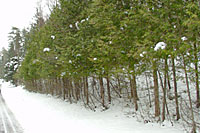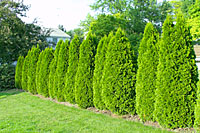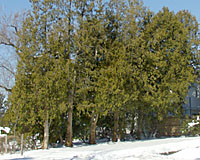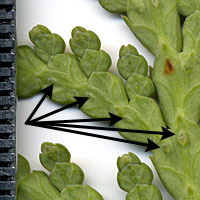Terry L. Ettinger Horticulture Consulting Services
Meeting The Needs Of Today With A Vision For The Future
Special Topics
Evergreen Identification
Arborvitae (Thuja)
 Eastern arborvitae (Thuja occidentalis) is native to Central New York and frequently referred to as white cedar
(or deer food - as they're a favorite food of white-tail deer during
the winter months, at right).
Eastern arborvitae (Thuja occidentalis) is native to Central New York and frequently referred to as white cedar
(or deer food - as they're a favorite food of white-tail deer during
the winter months, at right).
 Often planted close together along property lines to
create an evergreen hedge, many cultivated varieties (i.e., cultivars) can easily grow to widths of ten to twenty feet and
heights of fifteen to thirty feet - or more. This often results in
Often planted close together along property lines to
create an evergreen hedge, many cultivated varieties (i.e., cultivars) can easily grow to widths of ten to twenty feet and
heights of fifteen to thirty feet - or more. This often results in
 the shading and gradual loss of lower branches - and
their effectiveness as a privacy screen over the course of twenty to thirty years,
at right.
the shading and gradual loss of lower branches - and
their effectiveness as a privacy screen over the course of twenty to thirty years,
at right.
Arborvitae are relatively easy to identify as their tiny (1/16 inch to 1/8 inch), scale-like leaves are compressed to form fan-like branchlets that are very flat as compared to other evergreens with scale-like leaves.
 Another distinguishing
feature are very small, raised bumps or “glands” that are often found just below the tip of many, but not all of the leaves
on a branchlet, arrows at right.
Another distinguishing
feature are very small, raised bumps or “glands” that are often found just below the tip of many, but not all of the leaves
on a branchlet, arrows at right.